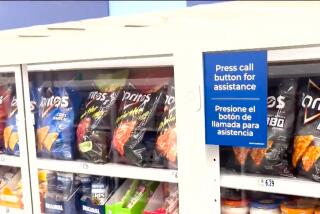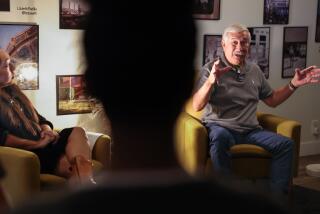Council Looks to Brush Up City’s Image : Aesthetics: Using four basic schemes would give a face lift to commercial areas, officials say. But some business owners fear the graffiti problem makes the idea moot.
COMPTON — The corner of Rosecrans Avenue and Acacia Street in Compton is dominated by a Weber’s Bread store, covered with blue and white checks like an enormous bag of white bread. City staff say the store would look better painted off-white with peach trim.
Down the street is a beauty salon painted deep aqua, offset by scrawling black graffiti. Staff would prefer it off-white, maybe beige, again with peach trim.
In fact, city leaders would like to see all of Rosecrans--a montage of bright and dull auto repair strips, churches, stores and a very pink motel--decked out in four basic colors: off-white, beige, tan or peach.
This month, the City Council will consider a Uniform Paint Ordinance that would spread these neutral colors like a sandstorm over every major street and boulevard in town, creating a mini-mall uniformity on the city’s main corridors.
“This is going to bring Rosecrans into the 21st Century, aesthetically,” Mayor Omar Bradley said.
For Bradley, who describes his administration as a massive cleanup operation, that first coat of sandy beige would be more than just paint. He sees it as the road to a new image for a city whose name has become synonymous with gangs and crime.
“We’re not going to be the laughingstock of the South Bay anymore,” Bradley said. “Compton will be the most peaceful, the most prosperous city in the South Bay within eight years.”
Those who own the small businesses that line Rosecrans between Alameda Street and Wilmington Avenue--the first area targeted for this municipal face lift--are less hopeful than the mayor.
“It would be nice to have all these businesses the same color,” said Paulette Ramsey, owner of Designer’s Touch Hair Salon. “But it wouldn’t last 15 minutes.”
The trouble, business owners say, is as old as spray paint.
“We paint the building, go home, come back, and there it is again--graffiti,” Ramsey said of her blue salon. “We had a pretty building there for a few minutes last week. It never lasts.”
And don’t talk to Ramsey’s landlord about paint. He has painted his shops so many times, at $450 each time, that he can’t talk about the color of his building without getting disgusted. The city has a graffiti abatement program, but it is often overworked or does not have the right color.
Compton spends about $200,000 a year to clean up after taggers and gangs, who coat city walls with messages, threats and territory markers.
If city crews had four basic colors to work with, cleaning up the mess would be easier and cheaper, and walls would lose the patchwork effect usually brought on by graffiti abatement, Assistant City Manager John D. Johnson said.
Painting the shops on Rosecrans is just the beginning. Drawings in the city’s urban design plan show the city as Bradley hopes it will be in a few years.
Every major street would have three basic colors to choose from--off-white, sandy beige, tan--plus a complementary shade. Peach is designated for Rosecrans, blue-gray for Long Beach Boulevard and rose for Willowbrook Avenue.
After color, the city would concentrate on signs, persuading owners to stop such practices as painting advertisements directly on their buildings. The city adopted a uniform sign ordinance years ago, but it remains largely ignored.
Then, maybe four years from now, the city would link the businesses further, with an architectural theme for the facades on every street.
Compton Boulevard and Willowbrook would be joined in an African-Egyptian theme, Atlantic and Rosecrans avenues by mission-style architecture. Most other streets would be granted the catch-all designation of postmodern.
Neighboring Lynwood has begun a similar upgrade with a Facade Improvement Program, offering $2,500 grants to business owners who want to add awnings, new signs and fresh paint. The city also plans to guarantee short-term loans through First State Bank, which would charge 5% interest, for those with more ambitious improvements in mind than facades, said Sol Blumenfeld, Lynwood community development director.
Bradley and Compton staff have begun negotiations with local lenders, hoping for a similar deal when they begin facade improvements.
Much of the overall blueprint for Compton’s face lift was adopted as the urban design element of the city’s General Plan in December, Johnson said. But the Uniform Paint Ordinance would be the first part of the plan to bring it home to business owners. The council is expected to pass it this month.
Once color and architecture are joined along the major streets, Johnson thinks it will be far easier to keep an upgraded image for the city.
“If you build to a certain standard of quality, other developers will come in and build up to that,” Johnson said. “Our problem has always been that people build differently here than in other communities.”
Johnson traces the city’s architectural dilemma to the 1933 earthquake that devastated the region.
The earthquake leveled much of the city’s graceful mission style and, with the area immersed in the Great Depression, Compton was rebuilt with boxy buildings that were slapped up with little thought to aesthetics, Johnson said. Square and drab became the architectural style that defined the city, he said.
Fighting that entrenched style will not be easy, or cheap, Johnson admits. The hardest part, he said, may be convincing small-business owners that the work and cost will be worth it.
Next to the Weber’s Bread store on Rosecrans is a dull-brown Laundromat and a small building whose sign proclaims, “Best Burgers.” Just under the roof overhang, Best Burger’s menu is painted in large script that wraps all the way around the building: “Fish Burgers, Fat Bacon Burgers, French Fries.”
Inside, business owner Ki Chik Kim looks skeptical of the idea that new paint would transform the neighborhood.
“Even if we were all the same color, they would still paint graffiti,” she said. “But new paint, that would look good.”
More to Read
Sign up for Essential California
The most important California stories and recommendations in your inbox every morning.
You may occasionally receive promotional content from the Los Angeles Times.










